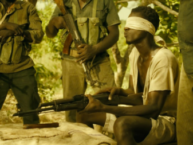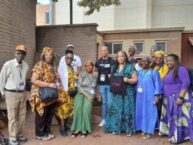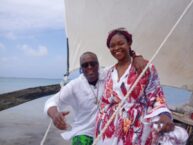Title: Interviews with Effervescent Writers
Editor: Christine Mautjana Publisher: Mbali Press
Reviewed by Emmanuel Sigauke
The package containing this book, shipped all the way from South Africa (to California) arrived in August 2012, when I was away in Zimbabwe. One of the writers featured in the book, Aryan Kaganof, whom I had just published on Munyori Journal, sent it to me for possible review. I am glad he did, because through reading the book, I have discovered new writers based in South Africa that I didn’t know before, writers whose books I am going to start looking for. This thin book of interviews (127 pages) is full of interesting perspectives on the writing process, on reading, and on writing politics in South Africa and elsewhere. These writers, according to the editor, are “effervescent”, which gives the reader the impression that they are full of energy, that they are in many ways bubbly, that they sparkle with creative energy, and, indeed, most of them do. The editor, Christine Mautjana, does a good job of asking thought-provoking questions which would make any writer sound or seem effervescent.
It is an ambitious little book, but it is also an impatient product. Let me start by addressing the impatience: I don’t know what the circumstrances for publication were, whether or not the book was a funded project with a deadline, or if a few folks (who write) put together some money and said, Hey, let’s publish this book, or if the editor self-published it; but I think it should have waited a bit, should have gone through the full process, everything from content revision to line editing, to design. That said, this book is still an important dream, and it challenges its readers to think in new ways about the writing process.
The book consists of eleven interviews with writers like Aryan Kaganof, Omoseye Bolaji, Maxwell Kanemanyanga, Hector Kunene and others. Reading the interviews, I discovered that Nigeria-born Omoseye Bolaji is central to the book, as nearly all the other featured writers refer to his work or his influence. In her introduction of the Bolaji section, Mautjana writes, “Omoseye Bolaji has benefitted prodigiously from being exposed to the historically vibrant west African literary milieu, and also the Southern African one….yet [he] deserves to be considered as a great African writer in his own right too, having published widely in many literary genres…” (p. 21). One gets to understand that Bolaji has won numerous South African awards, such as The Lifetime Achievement Award, the Chancellor’s Medal at the University of Free State, and an “authentic African Chieftainship.” Bolaji, who says he is grateful for all the awards, decries poor the reading culture in Africa, and advices writers to have jobs that support their livelihood. Bolaji also advocates for genre expansion in African writing, recommending an appreciation for popular fiction, instead of priviledging only literary works. He has written over fifteen books of fiction, one a mystery series featuring a character named Tebogo. He has also published drama and poetry. His interviews covers his process, as well as his experiences traversing the African literary landscape. He sounds humble in his approach to literature, yet is way aware that he has a sizeable following among young writers. Readers, of course, disappoint him a bit–they should read more.
Then there is Aryan Kaganof, the Munyori writer. It’s great that his is the first interview . He interviews well, and he has much to offer, has been writing for a long time. In some South African circles, he is described as “a one-man arts and culture industry.” Involved in anti-apartheid campaigns, he left South Africa in 1983 and lived in Holland, where he worked at the Dutch Anti-Apatheid Movement until 1986. He is a graduate of the Netherlands Film & Television Academy. He has won the Dutch award for his first feature film, “Kyodai Makes the Big Time”. And he returned to South Africa in 1999, and in 2000, he was a resident at the Yerba Buena Center for the Arts in San Francisco, here in Northern California. Aryan has been innovative in many ways: in 2005, he shot the world’s first feature film on a mobile phone camera, “SMS Sugar Man”, a film which led to his invitation to Sweden’s K3 Malmo University as a Visiting Professor.
Like some of the writers in this collection, Aryan Kaganof laments the state of reading in South Africa: “People don’t read. It’s a disaster. Politics, political freedom, the right to vote, it’s all bullshit if people don’t read. A nation that does not read is destined for the toilet. ..You cannot emancipate yourself from mental slavery, from any slavery, unless you read” (p. 11).
Kaganof is an interesting personality, and as stated, he interviews well. He has written over 25 books, and states that the reason he knew he would become a writer was that he hated working for a living. But when the writing began, it saved him from “the grueling period and place [Apartheid South Africa]” he grew up in. He says: “Because the so-called whites had it so good materially under apartheid it is easy to forget how incredibly tedious, constrained and numb that period was for the mind. The so-called white world was a very grey place to be” (p. 12). After saying this, he answers this question: “Let’s discuss your juvenilia–your youthful writings. This was part of honing your craft. Can you talk about this?” And Kaganof does talk–about this, about how he began writing–brief, before he goes back to his experience growing up in South Africa:
“The particularity of experience of growing up in Africa, in South Africa, as a so-called white, was incredibly debilitating. Looking back, I am amazed at how much crap one has had to shed, how much decolonizing of the mind one had to undergo in order to come out relatively sane. We were utterly brainwashed by the education system, by the church, by our parents, by the radio and then, much later, by TV. It was scandalous actually. The notion of European high-culture, of literary modernism, was in fact used as a stick to beat us in the same way…”
Aryan Kaganof speaks with an honesty that I wish I would hear from some of the white Zimbabwean writers, to really tell us how their world was, vis-à-vis the black world, to begin to tell us, in more interesting ways than already in place, what we need to know about the obvious, in other words, to give a new and interesting spin to the obvious realities of growing up in Rhodesia or Zimbabwe; it’s part of what the Zimbabwean reality requires if it’s to enter the path of racial healing. But I digress.
Kaganof has also published books under the pseudonym AK Thembeka, a name he was given by a petrol attendant when (perhaps instead of petrol) he asked for an African name. After a misunderstanding with Kwela Publishers on the issue of his name’s spelling, which he had presented on the book cover as Thempeka, he decided to self-publish the titles under that name–a kind of response to the shame that he would feel had he gone back to Kwela and dealt with the issue of spelling, but this self-publishing paid off as some readers like what he published under the name Thembeka, whose meaning connects to the idea of someone who can be trusted, someone honest; and this interview is one of the most honest I have ever read. So he self-published most of the works written under Thembeka, and he states that he has made more money on books he self-published than those published by mainstream publishers of South Africa, but he admits that the process took a lot of effort, which is a way of saying writers are better off with real publishers being responsible for the publishing end of things, while the writers focus on reading and writing, and more reading.
At the end of the interview, he goes back to the topic of reading: “Forget about writing for a while. First people have to read.”
His latest book is entitled “The Vuvuzela Murders”, which he hopes to publish before he dies.
There is a Zimbabwean writer interviewed in this book, a Zimbabwean writer I didn’t (and I know many Zimbabwean writers), Maxwell Perkins Kanemanyanga. He has published two short story collections, and one review of his work has said he writes about important issues, but he needs to tone down the prose, that he’s too verbose, and that got me googling him, that got me wanting to read him, really, to see how he treats the issues in his books, and how verbose he is. But his books, while listed, are not yet widely available on platforms like Amazon, Barnes and Noble and others.
In the interview he says: “It is strange….Initially I was what you might call an essayist; even crudely a letter writer. Then I was sort of spurred to write fiction–and it came out almost like the incessant flow of water from a healthy tap!” He has since been shortlisted for the Lorenzo Natalia and European Commission awards.
Kanemanyanga values reading as well. He has been influenced by the rich tradition of writing from Zimbabwe, but he has also been discovering other influences, and he particularly admires the work of the Nigerian writer Omoseye Bolaji, also featured in the interview book. Kanemanyanga likes Bolaji’s emphasis on reading in Africa, and he says: “Africans are rich people but all these years we are just beggars standing on our mineral and resources. … Our education is not fulfilling its purpose,’ it’s not serving the purpose of teaching us “to think intensively, critically and to equip us with the power to think objectively, not just read prescribed textbooks and boast about certificates hanged.”
There are other interesting writers featured in this book, NMM Dumani, Petro Schonfeld, Teboho Letshaba, George Rampai, and others. They give interesting insights on the writing process, and all emphasize the importance of reading. They are disturbed by the dying culture of reading, and some, like librarian Petro Schonfeld, suggest solutions, such forming more reading clubs, hold reading workshops, and creating readership networks, and utilizing social media to promote reading. There is, for instance, the Facebook group READ SA, and other ways to encourage reading on mobile devices. In short, just as there have been efforts to raise participation in African writing, there also have to be campaigns to promote reading, to create a balance. Perhaps, as Bolaji wishes, only then can African writers dream to make a living as writers.
Here is what Petro Schonfeld says about reading: “We have to be literate to achieve anything. And nowadays people tend not to read. Reading should be a habit…people tend to read only newspapers and news can be depressing. Literature enlivens your dreams, hopes” (p. 106).
It was refreshing that I didn’t know nearly all of these writers, so I saw this book as a work that seeks to give more exposure to African writers we don’t often hear of. Says the editor, Christine Mautjana: “The first thing to realize is that a work like this can only feature selected writers. It is impossible to interview all writers…real new talent emerges every year” (p. 6).
I can add that real new discoveries of writers are possible through books like this.






